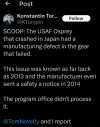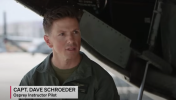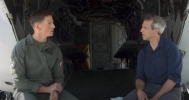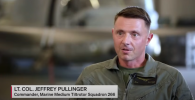We in the MV-22 community do not normally account for helo pads due to our size and extreme downwash. I'm sure many people here have seen the video of the CV-22 absolutely wrecking that hospital helipad in the UK.A couple of questions from a nonvertical lift guy, so excuse my ignorance.
- Land As Soon As Possible - The report noted a helo pad and a smaller airport closer than the airfield they chose to divert to, does helo/VSTOL land ASAP options usually take into account help pads? Is there comprehensive info on helo pad location easily available like airfields? Second part of question, is land ASAP put the aircraft down on any available spot or the closest pad/airfield? And is there a difference between 'Land ASAP' and 'Land Right Fucking Now!'?
- V-22 Single Engine? A quick search finds that the V-22 can fly single engine but has some limitations doing so, so why isn't shutting down the engine part of the EP for a chips light? Was a catastrophic failure not considered likely? Too risky? Or do you wait for secondaries like in the 53?
Our NATOPS has Land Immediately, Land ASAPossible, and Land ASAPractical. Land ASAPossible for me as an aircraft commander normally means take it to the nearest airfield, assuming that's only like 10-15 minutes away which most of the time it is CONUS. But if all I have is a training LZ in the middle of the desert, I'll take that, too. Land Immediately means I'm looking off the nose and putting the plane down wherever it looks remotely safe to do so, whether that's a road or some farmer's field.
Shutting down 1 engine will not help you if it's a gearbox chips issue. Our interconnected drivetrain means the gearboxes are still working, just off the good engine as opposed to both engines. The load is still the same from idle up to single engine power.








